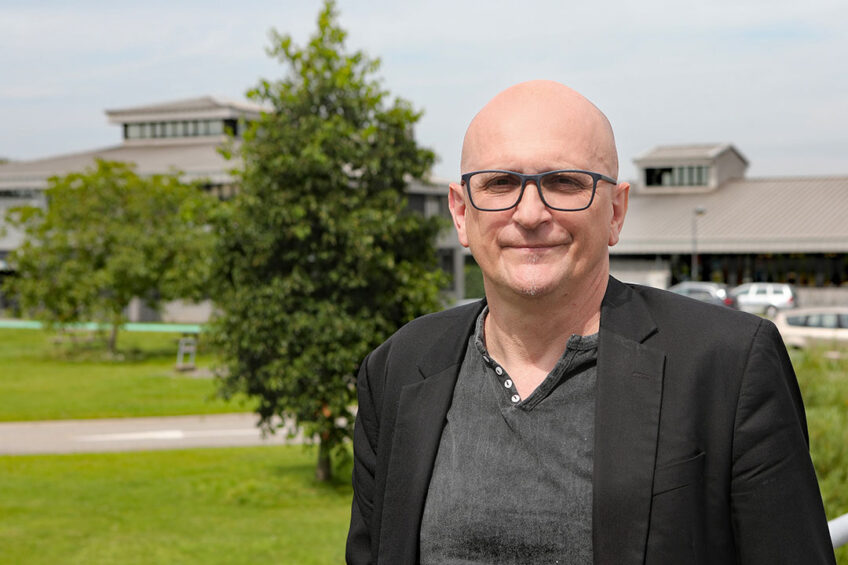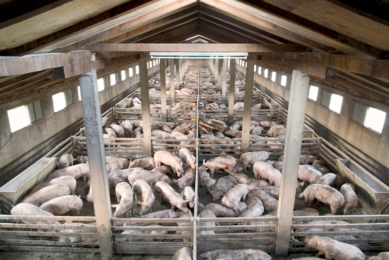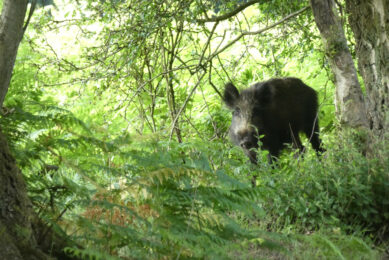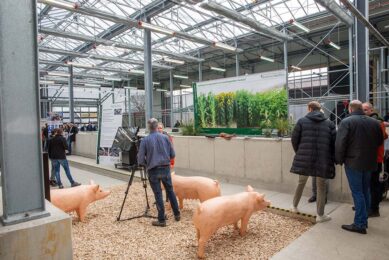Interview: “Veterinary virology is ahead in tackling viruses”

The approach to viruses in animal husbandry is better than the approach in human medicine. Human virology can learn a lot from that, says veterinary virologist Prof Hans Nauwynck.
Covid-19 has put the spotlight on virology. One virus expert after another appears on television programmes, almost all of them authorities in the field of human viruses. The experience gained in tackling viruses in livestock and pets is hardly discussed, even though there is a lot to be gained here, says scientist Prof Hans Nauwynck. “The successful way the veterinary world keeps viruses under control is an example for human virology. If the Covid-19 virus had only struck in pig farming, it probably would not have spread as fast as it does now in humans.”
Prof Hans Nauwynck (58) is a veterinary virologist. As a scientist, researcher and professor he is connected to Ghent University, Belgium, at the Laboratory for Virology, part of the Department of Virology, Parasitology and Immunology within the Faculty of Veterinary Medicine.
Prof Nauwynck has another message. He is extremely annoyed by the allegation that modern livestock farming is the cause of all pandemics and must therefore be curbed or eliminated. “Celebrities, politicians, writers and journalists just shout. Mostly nonsense. They have heard the bell tolling, but they do not know where the clapper is. It is true that a virus can circulate in a barn with many animals, but you can tackle it in that one barn with the necessary biosecurity measures. Blaming all the diseases in the world on livestock farming is nonsense. It is also correct that viruses can transfer from animals to humans, but that mainly concerns wild animals. Intensive livestock farming, which also falls victim to many virus introductions from the wild, is doing everything it can to prevent and control these types of infections.”
Then what about minks?
Hans Nauwynck: “Remarkable. Minks proved to be excellent hosts for Covid-19. They were infected by humans and not the other way around. The animals were culled because they were a danger to humans due to the formation of new variants. Mink farming fell victim to Covid-19 in humans. This was never properly communicated. From an ethical point of view, it made sense to stop these mink farms.”
What does that complete control consist of?
“Biosecurity in intensive livestock farming has become a completely logical system. Mind you, this does not concern hobby farmers, who can introduce a lot of problems. Consider, for example, avian influenza. But in order to enter a barn on an intensive pig farm, you must go through hygiene locks. Filters on the ventilation block everything. Livestock farms are highly isolated from the outside world.
With livestock, Covid would never have circulated so quickly
“In addition, there is a well-connected identification and registration (I&R) system: every animal, every farm, every transport has a number, with which they can be traced. It is completely controlled. Transport of an animal is rare and when it is transported, you must comply with all kinds of rules. It is all set up in such a way that we try to keep viruses out. You cannot say the same about humans. Only the I&R (passport, tickets) works. The rest (travel, contacts) much less so. In fact, it stops there. Humans travel freely around the world. In this way, we spread viruses all over the world in no time, which Covid-19 now shows.
“With livestock, the virus would never have circulated so quickly. Mass travel is not done. If a person wants to catch a flight, they should first check their health and make sure they are virus-free. Ill and virus-shedding people should not fly. Flying is not only an ecological but also a sanitary problem. Aimless human travel makes the world one big barn in which a virus has free rein. The question is, who has the courage to discuss this at the highest level of public health? Blaming livestock farming happens fast; discussing hot topics in humans is often postponed. After all, animals have no voting rights.”
Are there any other differences in the approach between humans and livestock?

“Look at the diagnosis of diseases. As veterinary virologists, we are very well trained to find out what causes a disease. Is it a virus or a bacterium and which one exactly?
This is essential for starting and improving treatment and prevention. If you go to the doctor with a cold or diarrhoea, you are usually advised to wait it out and to come back if it does not get better. Then you get antibiotics. It is not even determined which germs are involved, a bacterium, a virus or something else. And they do not prescribe specific antibiotics either.
You would hate to think that a virus that is just as deadly as African Swine Fever in pigs, and for which you have no cure, will strike humans
“That is no longer done. We have good and even revolutionary diagnostic technologies to really help vets and farmers. That goes one step further than a PCR test.
For example, we have a new technology within our spin-off PathoSense, which is already being used in Belgium, Germany and the Netherlands. It makes it possible to see in one test which virus or bacterium it is and which antibiotic we should use, against which the bacterium is not resistant. Furthermore, the knowledge of viral and bacterial diseases is better than in human medicine. We have the advantage of testing directly on the relevant animal species; in humans, it is necessary to work with mice or other animals with an adapted virus. That is a big difference. In addition, there is extensive experience with vaccines to control infectious diseases and even to eliminate viruses in a targeted manner.”
What else needs to be done?
“Much more money is needed for research. Covid-19 is a coronavirus. There are many more coronaviruses, which are even more aggressive, such as the feline infectious peritonitis (FIP) virus that kills up to 5% of cats. We need to look at that, so we can find a vaccine for those coronaviruses in time. You would hate to think that a virus that is just as deadly as African Swine Fever in pigs, and for which you have no cure, will strike humans. It would lead to an unimaginable disaster. With African Swine Fever, you can see how bad it will turn out if you underfund research. We have known for years that the virus was coming. Money has become available much too late to combat it. Currently, we are trying to empty the ocean with a thimble. African horse fever is also knocking on the door.”
Surely there is a realisation now that money must be put on the table to prevent such disasters.
“Let’s hope so. Otherwise, we have learned nothing. Until now, it has always been very difficult to get money for veterinary viruses. Hopefully this will change because it is really urgent. You should not wait, because waiting is a very bad attitude. I also do not understand why the health insurance world is not investing more money in better diagnostics. They currently do not reimburse the diagnosis of most viral and bacterial diseases. It pays off twice if you can intervene faster and more specifically, as we do in animal husbandry. Letting infectious diseases drag on causes many hospital admissions with expensive costs.
“In intensive livestock farming, you see that continuous efforts are made to increase biosecurity to a very high level. What matters is that we wake up now and start working hard together as human and veterinary virologists. And let’s also realise that as long as there will be humans and animals, there will be zoonoses (animal-to-human) and reverse zoonoses (human-to-animal) at risk of escalating into a pandemic. There is insufficient or incorrect discussion about reverse zoonoses. Animals cannot write articles.”
Working together on One Health
Prof Hans Nauwynck argues that human and veterinary virology should cooperate more. “We have to build bridges. This is starting to take off, luckily. There used to be a big barrier between virologists. There was a sense of supremacy among the human virologists. That difference is now largely gone. We find each other more and more. The human sector should take a good look at what we have already achieved in the animal sector. The ideal is to work together on a “One Health” approach. We know that wildlife is a reservoir of viruses. We must learn from each other. We also must be realistic. In animal husbandry we accept a mortality rate of about 1%. Of course, that is not acceptable in humans.”











